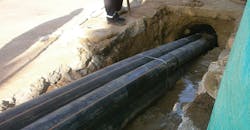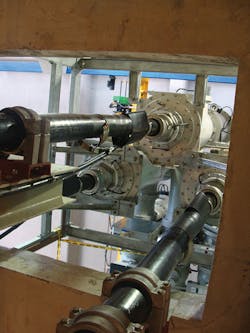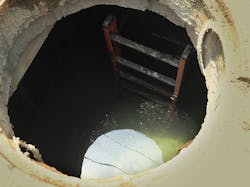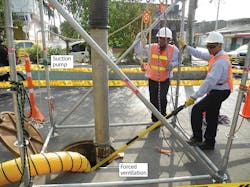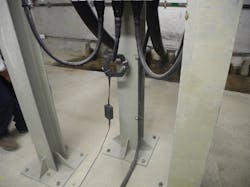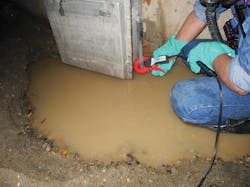Maintenance Strategies for Underground Cables
The number of extra-high-voltage alternating-current (AC) underground cable systems installed in Colombia has grown rapidly. And Interconexión Eléctrica S.A. E.S.P. (ISA) experienced difficulties when implementing its preliminary maintenance program for the first 220-kV AC cross-linked polyethylene (XLPE)-insulated underground cable circuit installed in Colombia. This led ISA engineers to develop an improvement project to define the technical specifications for cable and the maintenance procedures.
With the assistance of external experts, ISA sought to reduce the cost and improve the reliability of its XLPE-insulated cable assets in various countries. The improvements would incorporate new monitoring technologies such as distributed temperature sensing (DTS) and on-line measurement of partial discharge in terminations and joints. The monitoring systems would provide information in real time and be stored in a database that could be used to improve the assessment of the condition of cable systems and their integrity. The strategy ISA considered for its maintenance program was reliability-centered maintenance (RCM) focused on applying the most recent preventive and predictive methodologies.
The first 220-kV AC XLPE-insulated underground cable circuit, El Bosque was installed in the historic city of Cartagena, Colombia, and energized in 2013. This was a 2-km (1.2-mile) double-circuit 220-kV installation. ISA’s Brazilian transmission utility, CTEEP, has 222 km (137 miles) of underground cable in commission in three transmission line system circuits. CTEEP energized the first line, which operates at 230 kV, in 1976. The two remaining lines operate at 345 kV and were installed in 1979 and 1999. Installed in the metropolitan region of São Paulo, Brazil, they are low-pressure fluid-filled cables, have copper cores with a lead sheath and a metallic screen. However, CTEEP lacks experience in the maintenance of XLPE-insulated underground cable systems.
Existing Program
The existing maintenance program adopted by ISA utilities was developed by CTEEP, which has many of the extra-high-voltage/high-voltage (EHV/HV) cables that are the low-pressure oil-filled cable design. The maintenance program includes the following regularly scheduled activities:
• Daily inspection of the cable route and crossings
• Weekly oil pressure measurements
• Fortnightly tunnel inspection
• Monthly manhole/joint pit inspection
• Quarterly inspection of hydraulic connections, oil tanks and alarm testing
• Annual cross-bonding inspection
• Every six years, calibration of pressure gauges and switches as well as tan δ and residual gas pressure (RPG) measurements.
Beginning with the commissioning of the El Bosque project, a preliminary maintenance program was developed for XLPE-insulated high-voltage cables, with the objective of assessing the condition of the asset during its whole life cycle to extend its useful life and avoid failures. This was based on the recommendations of cable manufacturers and experience of some of ISA’s subsidiaries.
Developed in 2015, the maintenance program for El Bosque adopted the routine inspection tasks used by CTEEP in addition to the following three annual test procedures:
• Measurement of partial discharge on cable joints and terminations
• Measurement of the circulating currents of the cross-bonding system on the metallic sheaths
• Thermographic inspection of the terminations.
While executing the maintenance procedures on the 220-kV XLPE-insulated underground cable El Bosque circuit, the technical team had difficulties performing some of the specified testing. For example, there were difficulties with induced current measurements in the metallic sheet, thermographic inspection of the link boxes, and partial-discharge measurement with high-frequency sensors in the coaxial cables that interconnect the metallic sheet of the cable joints and the link boxes.
One of the major problems was due to the high water table level in the region. Activities requiring access to the link were problematic because cable joint boxes were usually water filled. Hence, additional activities like water pumping were necessary for tasks like circulating current measurements on connection cables to earth and partial-discharge measurements on terminations. As a result, it took longer to complete the tasks.
Program Development
Initially, ISA undertook a survey of state-of-the-art methods and technologies available for the assessment of the condition of the insulated cable systems and tasks generally employed in preventive maintenance programs. Data also was collected on the events and causes of the damage most likely to occur to high-voltage extruded insulated cables. The findings revealed the following:
• The majority of the damage to the cables was caused by third parties
• Damage to the outer sheath of the cables caused by third parties, brittleness of the sheath, external contamination by solvents, oil and oil products, and bitumen
• Damage to the metal sheath (corrosion or fatigue) caused by third parties
• Moisture penetration in the insulation
• External mechanical stresses due to soil movement, expansion and thermal contraction (snaking), and incorrect clamps
• Poor standards of workmanship during installation, causing increased electrical stress in joints and terminations
• Water penetration in the joint pits and link boxes
• Failure of the forced cooling system, where installed.
The search of the main causes of cable failure, their qualitative probability of occurrence, and studies of the consequences and impact of these failures were subject to detailed analysis to determine the maintenance actions that can be taken to mitigate them.
Predictive Maintenance
Predictive maintenance is a strategy based on measuring the condition of equipment to assess whether it will fail during some future period, and then taking the appropriate action to avoid the consequences of that failure. Because of ISA’s studies, the predictive maintenance program to assess the condition of the cable systems includes the following selected methods:
• Monitoring the distributed temperatures of the cables (DTS), with the daily recording of the temperatures along the cable circuit and any eventual alarms of temperature above the cable limits
• Measuring partial discharge on cables, joints and terminations every five years in a real-time partial-discharge monitoring system
• Annually inspecting terminations, link boxes, connections to the grounding system, connecting cables and joints accessible to the maintenance personnel
• Measuring the circulating currents in the metallic sheaths of the cross-bonding system on an annual basis.
Preventive Maintenance
Preventive maintenance is undertaken at predetermined intervals or prescribed criteria intended to reduce the probability of failure or the degradation of the asset. According to developed studies, the preventive maintenance for high-voltage underground cables includes the following tasks:
• Inspection of cable routes at daily or monthly intervals depending on the location of the cable route
• Voltage tests applied on the cable sheath every five years
• Annual visual inspections of joints in the boxes with access
• Annual visual inspection of the terminations, observing the cleanliness condition and deterioration of jumpers and interconnection connectors, rings and anti-corona protections, insulators, sealing welds, screws and lock nuts on the support structures, connectors and interconnection cables with the grounding system
• Cleaning the insulators on terminations, with intervals varying according to the rate of pollutant deposition on the equipment
• Visual inspection of the link boxes on an annual basis
• Annual visual inspection of the grounding system
• Earth resistance measurement of the grounding system every five years
• Monthly visual inspection of the civil structures such as tunnels, galleries and joint boxes, observing the maintenance and operating conditions; this includes the lighting system, infiltration of water or other liquids, gases, accessibility conditions, safety facilities, stability of concrete structures, presence of cracks in the walls or covers, irregularities in the walls or repression on the covers, operating condition of the ventilation system, operating condition of the alarm and firefighting systems, state of the covers and existence of invasions
• Annual visual inspection of the supporting structures of the terminations, joints and cables to observe corrosion of support metallic structures of cables and joints, corrosion of fixing clamps, sediment deposition on cables and joints, loose fastening clamps and regular arrangement of cables, for example, in sinusoidal format (snaking).
This program will be updated periodically according to the RCM strategy and experience acquired by the maintenance personnel in the different countries, coupled with any new technologies developed and introduced in the market. The revision of this program also will consider the expenditure on maintenance and asset reliability.
Notable Improvements
Even though ISA has not implemented its maintenance program fully, the utility has seen notable improvements already. One of the major improvements is the revision of specifications for the purchase of materials and contracting services. They are now more complete with greater technical detail to ensure improved design and installation of the EHV/HV underground cable systems.
On-line monitoring systems like DTS and partial discharge will be introduced as standard in all new installations to reduce expenditure on operation and maintenance.
The specification for all new EHV/HV cables now includes optical fibers that work with the real-time technologies now being used, which will improve circuit reliability as well as reduce the likelihood of cable failures and shutdowns in the future.
All joint boxes are now being designed with dimensions adjusted to facilitate future maintenance, thereby reducing costs as well as construction and maintenance times compared to the first 220-kV underground cable circuit designed XLPE insulation.
It is estimated the updated maintenance program, implementation of monitoring systems and relocation of link boxes (which make it easier for maintenance personnel to access) will result in a 40% reduction in the operation and maintenance costs associated with ISA’s EHV/HV XLPE-insulated underground cable circuits.
ISA is expanding its portfolio of 220-kV XLPE-insulated underground cable circuits with the installation of a 5-km (3.1-mile) double-circuit project, the Planicie-Industriales in Lima, Peru. Furthermore, a 220-kV XLPE-insulated 5.2-km (3.2-mile) single-circuit underground cable project, the Caracolí, is in the design phase in the city of Barranquilla, Colombia.
Finally, feasibility studies are now in progress to interconnect the Colombia and Panama transmission systems with a 300-kV high-voltage direct-current overhead transmission line that includes a section of submarine cable some 35 km (21.7 miles) in length. ♦
Antonio Pedraza Lozano has been an engineer at Interconexión Eléctrica S.A. E.S.P. since 1995 and is currently a specialist of the transmission line engineering team. His fields of interest are analysis of power systems, transmission lines and electromagnetic transients. Lozano has a degree in electrical engineering from the University of Antioquia, Medellin, Colombia; a master’s degree in analysis of power systems from the Federal University of Santa Catarina, Brazil; and a degree in management of energy companies from the School of Engineering of Antioquia.
Mallory Suárez Medina is currently an engineer at Interconexión Eléctrica S.A. E.S.P. Intercolombia. She holds a degree in electrical engineering from the Universidad del Norte, Barranquilla, Colombia, and has five years of experience in maintenance management of overhead and underground transmission lines. Medina develops technical assessment of the condition of transmission lines, which includes the preparation of specialized studies, analysis of anomalies found in the different line components and analysis of new material technologies.
Julio Cesar Ramos Lopes is a director of Inovatec Consultoria e Engenharia Ltds. and a member of the IEEE. Lopes held management positions for more than 25 years at AES Eletropaulo in engineering, system planning, design and construction of high-voltage and extra-high-voltage substations and transmission lines. He served as chairman of the SC B1 Insulated Cables of the Brazilian National Committee of CIGRE from 2008 to 2014. He holds a degree in electrical engineering from the Polytechnic School and an international executive MBA degree from the Fundação Instituto de Administração of the University of São Paulo, Brazil.
Sidebar: Development of ISA
Colombian state-owned holding company Interconexión Eléctrica S.A. E.S.P. operates in Latin America’s power, telecom and highway concession sectors. Founded in 1967, it is one of the largest transmission utilities in Latin America. It now has concessions in eight countries and is responsible for an extra-high-voltage/high-voltage transmission system that is 41,650 km (25,881 miles) in length and has 26,700 km (16,591 miles) of fiber-optic cable. The total transformer capacity in operation is 77,710 MVA, with a further 11,125 MVA of transformer capacity being installed in projects currently under construction.
